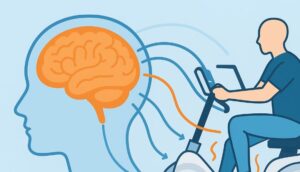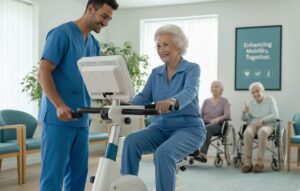
What is spasticity?
Spasticity is a condition in which muscles become stiff and difficult to control. It can lead to pain, muscle weakness, and difficulty with movement. By using the active passive cycle trainer, individuals with spasticity can improve their muscle control and coordination.
An active passive cycle trainer is a rehabilitation device that can be used to improve movement and decrease spasticity in individuals with neurological conditions such as spinal cord injuries, stroke, multiple sclerosis, and cerebral palsy.
The active passive cycle trainer works by allowing the user to pedal with their legs while the device provides additional support and resistance to the movement. This type of exercise can help to improve blood flow, increase range of motion, and reduce spasticity in the legs.
In addition, the active passive cycle trainer can help to improve overall cardiovascular fitness and endurance, which can also contribute to improved movement and reduced spasticity.
Overall, the active passive cycle trainer can be a useful tool in the rehabilitation of individuals with neurological conditions, as it provides a safe and effective way to improve movement and reduce spasticity.

Spasticity in neurological conditions
Spasticity is a common symptom in many neurological conditions, including spinal cord injuries, stroke, multiple sclerosis, cerebral palsy, and traumatic brain injuries. It is characterized by involuntary muscle contractions, stiffness, and spasms that can interfere with movement and range of motion.
In normal muscle function, muscles contract and relax in response to signals from the nervous system. In individuals with spasticity, however, the nervous system sends abnormal signals that cause muscles to contract excessively, leading to stiffness and spasms.
The severity of spasticity can vary widely, from mild muscle stiffness to severe muscle contractions that interfere with movement and daily activities. Spasticity can affect different parts of the body, depending on the underlying neurological condition.
Spasticity can have a number of negative effects on an individual’s health and well-being, including muscle pain, joint stiffness, and muscle weakness. It can also lead to complications such as pressure sores and contractures, which can further limit mobility and independence.
Fortunately, there are a number of treatments available to help manage spasticity in neurological conditions. These treatments may include medications, physical therapy, occupational therapy, and the use of assistive devices such as braces or orthotics. In some cases, surgery may be recommended to release tight muscles or tendons.
Overall, the management of spasticity is an important aspect of the rehabilitation of individuals with neurological conditions, as it can improve mobility, reduce pain, and improve overall quality of life.
A Cycle Trainer Can Help!
An active passive cycle trainer can help to improve movement and reduce spasticity in individuals with neurological conditions by providing a safe and effective way to exercise the legs. The device allows users to pedal with their legs while providing additional support and resistance to the movement, which can help to improve blood flow, increase range of motion, and reduce spasticity. By using the cycle trainer, individuals can improve their muscle control and coordination, which can lead to improved mobility and overall quality of life.




